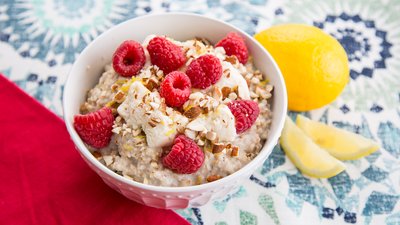Oats are like Clark Kent and his alter ego, Superman: They can be the most timid whole grain in your pantry, but they make an amazing transformation when punched up with some creative, nutritious toppings.
Before we get to toppings, let's give oatmeal its props as a superfood. Researchers at Louisiana State University determined that eating oatmeal in the morning makes you feel fuller for longer than if you took in the same number of calories from a boxed ready-to-eat cereal.[1] The hero in this satiety story is the soluble fiber called beta-glucan, which thickens when it mixes with liquid in your stomach. This combo leads to slower digestion and slower increases in blood sugar, both of which can help quell hunger. Beta-glucan also helps maintain healthy cholesterol numbers for better heart health.
Other research suggests that oatmeal acts as a prebiotic, something that feeds and, in turn, grows the population of beneficial bacteria in your gut. [2] What's more, oats provide high-quality complex carbohydrates to energize daily workouts, along with a range of essential nutrients, including B vitamins, magnesium, and phosphorus.
So, the next time you wake up hungry for oatmeal, deck out your bowl with any of these power couples!
The Foundation: Start with Perfect Oats
Skip the rolled oats or sugar-laden instant oats and buy the heartier, steel-cut version. For a fast getaway in the morning, use this overnight-soaking trick:
Click Here For The Perfect Oats Recipe!
Topping 1: Ricotta and Raspberries
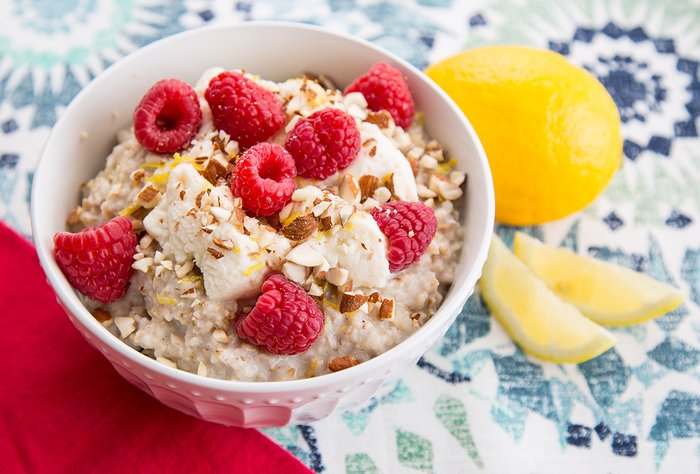
This dynamic duo supplies oatmeal with a creamy sweetness that's sure to release an early-morning dopamine surge. Ricotta cheese adds additional calcium and protein to your morning routine, and is one of the best dairy sources of whey protein, a nutrient that helps build muscle.
A study in the American Journal of Clinical Nutrition indicates whey protein helps maintain healthy blood pressure.[3]
The raspberries add natural sweetness and they're a fiber powerhouse, with 4 grams for every half-cup serving. Plus, they're a good source of vitamin C.[4]
Click Here For The Ricotta And Raspberries Oats Recipe!
Topping 2: Carrots and Walnuts
Many people struggle to eat enough vegetables, so why not use oatmeal to sneak in a little more? Shredded carrot adds earthy sweetness and beta-carotene, which your body converts into immune-boosting vitamin A. A Journal of Nutrition study found that higher consumption of beta-carotene helps maintain healthy cholesterol levels.[5]
Crunchy walnuts are a leading source of the omega-3 fatty acid alpha-linolenic acid (ALA). Among people with normal waist circumferences, ALA has been associated with the ability to maintain healthy blood-sugar levels. [6]
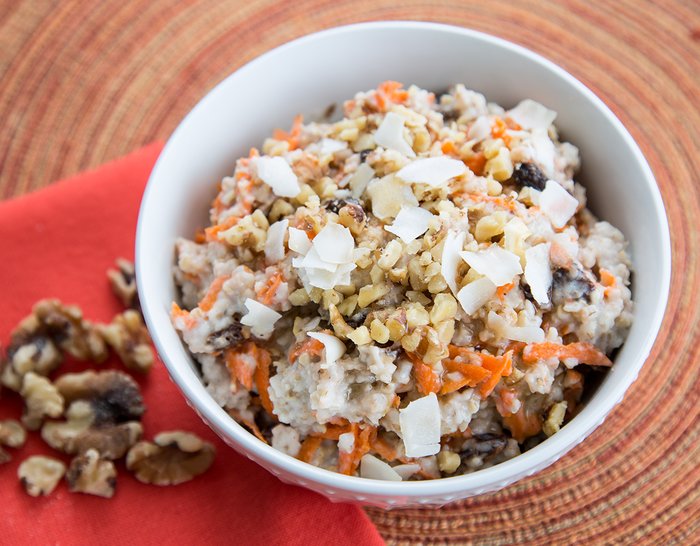
Click Here For The Carrots And Walnuts Oats Recipe!
Topping 3: Matcha and Avocado
An ultra-healthy import from Japan, matcha is like green tea on steroids. Made by finely grinding up green tea leaves, matcha provides huge amounts of the potent antioxidant epigallocatechin-3-gallate (EGCG). In fact, one study found that matcha can supply up to 137 times more EGCG than typical green tea prepared by steeping the tea leaves.[7]
Matcha is also a good source of caffeine and the compound L-theanine, both of which have been shown to improve attention and memory, and maybe dissolve your morning brain fog.[8]
Avocado is another nutritional overachiever, full of fiber, cholesterol-busting monounsaturated fat, and a range of vitamins and minerals, including potassium, vitamin K, and vitamin C.
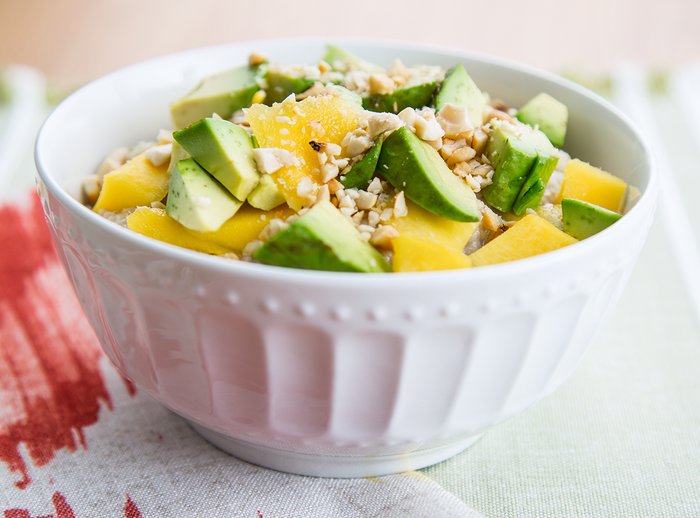
Click Here For The Matcha And Avocado Oats Recipe!
Topping 4: Egg and Baby Spinach
Most people think of oatmeal as a sweet dish, but it can also become a savory porridge. So get cracking and top off your bowl with a poached egg! A recent study published in the American Journal of Clinical Nutrition found that people following a high-egg diet (an average of 2 eggs each day) had about the same blood cholesterol numbers as people on a low-egg diet (eating less than 2 eggs a week).[9]
What's more, egg lovers reported less hunger and greater satiety following their breakfast. Credit the high-quality protein in the whites for making a breakfast egg dish stick with you longer.
Baby spinach has a neutral flavor, so it can sneak its way into oatmeal without making your morning meal taste like a salad. A touch of spinach will give you extra doses of beta-carotene, vitamin C, and vitamin K.[10]
This savory oatmeal can also perform double duty as a satisfying lunch.
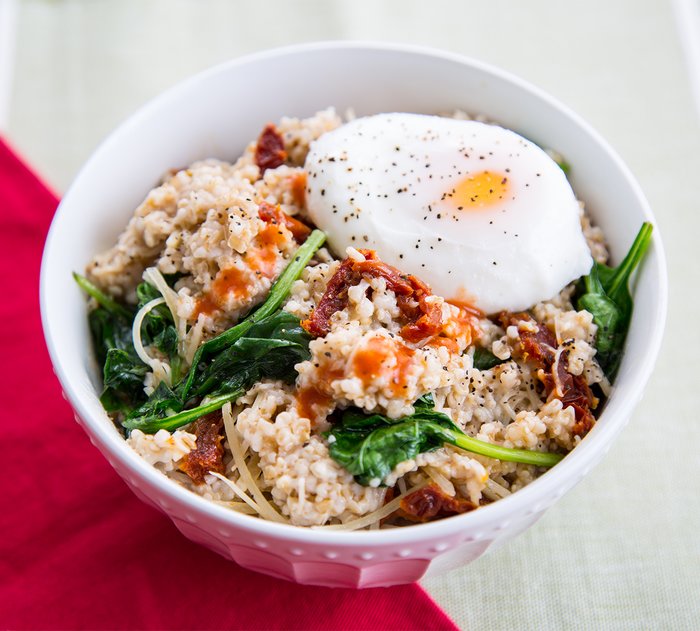
Click Here For The Egg And Baby Spinach Oats Recipe!
References
- Rebello, C. J., Johnson, W. D., Martin, C. K., Xie, W., O’Shea, M., Kurilich, A., ... & Greenway, F. L. (2013). Acute effect of oatmeal on subjective measures of appetite and satiety compared to a ready-to-eat breakfast cereal: a randomized crossover trial. Journal of the American College of Nutrition, 32(4), 272-279.
- Valeur, J., Puaschitz, N. G., Midtvedt, T., & Berstad, A. (2016). Oatmeal porridge: impact on microflora-associated characteristics in healthy subjects. British Journal of Nutrition, 115(01), 62-67.
- Fekete, Á. A., Giromini, C., Chatzidiakou, Y., Givens, D. I., & Lovegrove, J. A. (2016). Whey protein lowers blood pressure and improves endothelial function and lipid biomarkers in adults with prehypertension and mild hypertension: results from the chronic Whey2Go randomized controlled trial. The American Journal of Clinical Nutrition, 104(6), 1534-1544.
- Harding, A. H., Wareham, N. J., Bingham, S. A., Khaw, K., Luben, R., Welch, A., & Forouhi, N. G. (2008). Plasma vitamin C level, fruit and vegetable consumption, and the risk of new-onset type 2 diabetes mellitus: the European prospective investigation of cancer–Norfolk prospective study. Archives of Internal Medicine, 168(14), 1493-1499.
- Wang, Y., Chung, S. J., McCullough, M. L., Song, W. O., Fernandez, M. L., Koo, S. I., & Chun, O. K. (2014). Dietary carotenoids are associated with cardiovascular disease risk biomarkers mediated by serum carotenoid concentrations. The Journal of Nutrition, jn-113.
- Heskey, C. E., Jaceldo-Siegl, K., Sabaté, J., Fraser, G., & Rajaram, S. (2016). Adipose tissue α-linolenic acid is inversely associated with insulin resistance in adults. The American Journal of Clinical Nutrition, 103(4), 1105-1110.
- Weiss, D. J., & Anderton, C. R. (2003). Determination of catechins in matcha green tea by micellar electrokinetic chromatography. Journal of Chromatography A, 1011(1), 173-180.
- Dietz, C., & Dekker, M. (2017). Effect of Green Tea Phytochemicals on Mood and Cognition. Current Pharmaceutical Design.
- Fuller, N. R., Caterson, I. D., Sainsbury, A., Denyer, G., Fong, M., Gerofi, J., ... & Markovic, T. P. (2015). The effect of a high-egg diet on cardiovascular risk factors in people with type 2 diabetes: the Diabetes and Egg (DIABEGG) study—a 3-mo randomized controlled trial. The American Journal of Clinical Nutrition, 101(4), 705-713.
- 10. Juanola-Falgarona, M., Salas-Salvadó, J., Martínez-González, M. Á., Corella, D., Estruch, R., Ros, E., ... & Lapetra, J. (2014). Dietary intake of vitamin K is inversely associated with mortality risk. The Journal of Nutrition, 144(5), 743-750.

